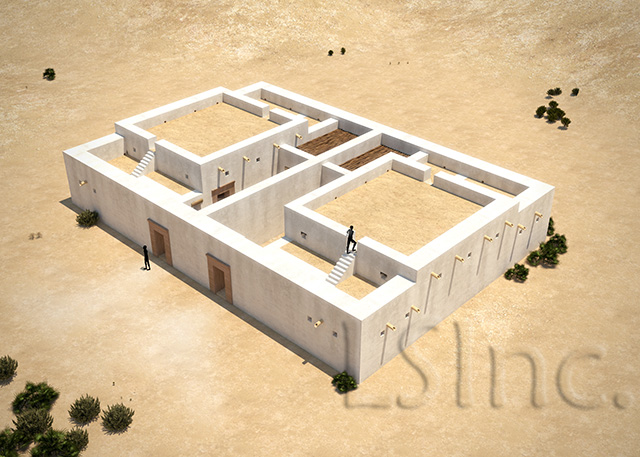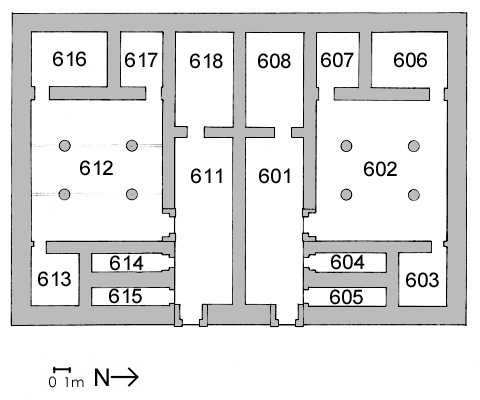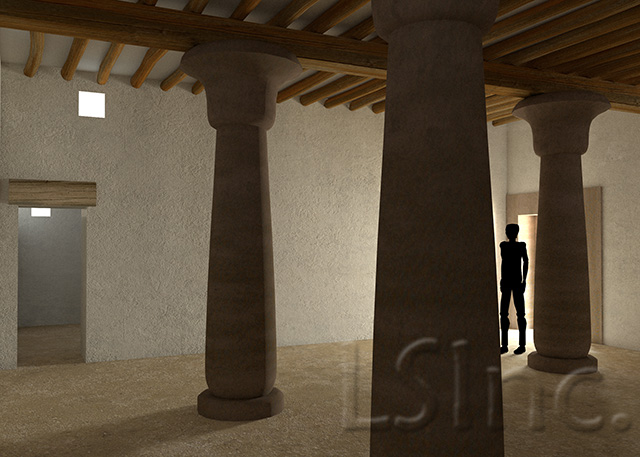Text for the excavation and description of this Meroitic double house was prepared for Learning Sites by Dr. Timothy Kendall (in 2001, then Research Scientist, Dept. of African-American Studies, Northeastern Univ.), Director of the Joint Mission of Northeastern University, Boston, and the Sudan National Corp. for Antiquities and Museums (NCAM), and currently (2016) Director of the Qatar-Sudan Archaeological Project.
 Because of the extensive settlement remains we were finding under cemetery AM E (see site plan to the left; hover over to enlarge), it seemed logical to select AM 600 as the next large structure to explore, since it lay immediately adjacent to this burial ground. During our mapping of the visible buildings the previous December, we discovered, based on the distribution of their stone fragments, that AM 600 and AM 200 were built according to the same plan. The only obvious difference between them seemed to be that AM 200 had formal stone doorways on its north, south, and east walls, while AM 600 had them only on its east wall. It also appeared that each building was symmetrical in its halves. We could thus be reasonably sure that if we could recover
at least half of the plan of AM 600 (which was undertaken during November 9-27, 2000), this would allow us not only to restore its full plan but also that of AM 200 with reasonable certainty.
Because of the extensive settlement remains we were finding under cemetery AM E (see site plan to the left; hover over to enlarge), it seemed logical to select AM 600 as the next large structure to explore, since it lay immediately adjacent to this burial ground. During our mapping of the visible buildings the previous December, we discovered, based on the distribution of their stone fragments, that AM 600 and AM 200 were built according to the same plan. The only obvious difference between them seemed to be that AM 200 had formal stone doorways on its north, south, and east walls, while AM 600 had them only on its east wall. It also appeared that each building was symmetrical in its halves. We could thus be reasonably sure that if we could recover
at least half of the plan of AM 600 (which was undertaken during November 9-27, 2000), this would allow us not only to restore its full plan but also that of AM 200 with reasonable certainty.
We started clearing the sand from the north end of AM 600 on and soon exposed a hard low mound of melted mud-brick, much like that of AM 700. Localized excavation around the shaft of one column over the next few days revealed that the ancient floor level lay 1.12 m deep and that the columns, within this very hard layer, remained standing to a height of two or three drums. The upper parts of the columns had toppled over and were scattered nearby,
partly buried in the mud surface; their exposed elements were badly worn by wind erosion. By sweeping the surface of the mud mound, we were easily able to detect the lines of the original walls of the rooms and their doorways. In some places, the walls were made even more conspicuous by the darker color of their mud. After clearing about 2/3 of the surface of AM 600 and tracing its walls, we were able to reconstruct its entire ground plan.
 AM 600 proved to be a large mud brick double house containing two symmetrical luxury dwellings, built within a single enclosure wall 26.3 m, north to south, by 18.25 m, east to west (or approximately 35 by 50 Egyptian royal cubits; note that this width measurement is also identical to that of the exposed south end of AM 700). This outer wall, 1.09 m thick, had been entirely coated on the exterior with a thick white kaolin plaster, indicating that the house would have appeared white on the outside (see the rendering of AM 600 at the left; hover over to enlarge). A wall 70 cm thick divided the structure in half, creating on each side a separate house of eight rooms. We numbered the rooms of the north house 601-608 and the corresponding rooms of the south house 611-618.
AM 600 proved to be a large mud brick double house containing two symmetrical luxury dwellings, built within a single enclosure wall 26.3 m, north to south, by 18.25 m, east to west (or approximately 35 by 50 Egyptian royal cubits; note that this width measurement is also identical to that of the exposed south end of AM 700). This outer wall, 1.09 m thick, had been entirely coated on the exterior with a thick white kaolin plaster, indicating that the house would have appeared white on the outside (see the rendering of AM 600 at the left; hover over to enlarge). A wall 70 cm thick divided the structure in half, creating on each side a separate house of eight rooms. We numbered the rooms of the north house 601-608 and the corresponding rooms of the south house 611-618.
 Each of the house units had on its east side a front door (see the plan at the left; hover over to enlarge). The doors of the respective units were 4 m apart, and each was framed by stone jambs and a lintel with cornice. Each opened onto an apparently roofless corridor 3 m wide and nearly 10 m long (601/611), which gave access to the various rooms of the house.
Each of the house units had on its east side a front door (see the plan at the left; hover over to enlarge). The doors of the respective units were 4 m apart, and each was framed by stone jambs and a lintel with cornice. Each opened onto an apparently roofless corridor 3 m wide and nearly 10 m long (601/611), which gave access to the various rooms of the house.
 The main room of each residence was an airy "loggia" or living room, 7.60 by 8.58 m in area (602/612), which was also entered through a formal stone doorway (see our rendering of the room at the left; hover over to enlarge). Its walls, like the exterior of the house, were plastered white, and will probably be found to have carried painted decoration. The ceilings of these rooms were supported by four stone papyriform columns, more graceful than those in AM 700 since they were one drum higher and stood 3.14 m. We can guess that the columned room 703 of AM 700 was identical in form to AM 602/612 and also functioned as the central living room of a private residence. These columned rooms would have been the highest spaces in their respective house units and would have been lit by clerestory windows set in the walls above the level of the roofs of the surrounding rooms.
The main room of each residence was an airy "loggia" or living room, 7.60 by 8.58 m in area (602/612), which was also entered through a formal stone doorway (see our rendering of the room at the left; hover over to enlarge). Its walls, like the exterior of the house, were plastered white, and will probably be found to have carried painted decoration. The ceilings of these rooms were supported by four stone papyriform columns, more graceful than those in AM 700 since they were one drum higher and stood 3.14 m. We can guess that the columned room 703 of AM 700 was identical in form to AM 602/612 and also functioned as the central living room of a private residence. These columned rooms would have been the highest spaces in their respective house units and would have been lit by clerestory windows set in the walls above the level of the roofs of the surrounding rooms.
Each living room of AM 600 was connected to three internal rooms:
These houses, with their central 4-columned halls, bear striking similarity to many ancient Egyptian houses of the New Kingdom. At the same time, they are also remarkably similar in many respects to modern Sudanese houses. Based on comparisons with both ancient and modern parallels, AM 600 can be quite convincingly restored as we present above. However, these renderings are only tentative and will surely be modified as we learn more.